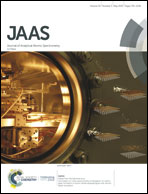Quantitative analysis of chromium in pork by PSO-SVM chemometrics based on laser induced breakdown spectroscopy
Abstract
In order to improve the stability and prediction accuracy of a Laser Induced Breakdown Spectroscopy (LIBS) quantitative analysis model a chemometrics method named PSO-SVM (particle swarm optimization-support vector machine) is proposed for the quantitative prediction of heavy metal chromium (Cr) in pork by analyzing the spectral data obtained by LIBS. The usable spectral region from 424.77 to 429.99 nm was identified. The normalized preprocessing of spectra was employed. Also, the spectral dimension was reduced through principal component analysis (PCA). The PSO algorithm was applied to select the SVM hyper-parameters including the regularization and kernel parameters. The calibration model of heavy metal Cr in pork was established using the optimum hyper-parameters obtained by PSO-SVM. The performance of this PSO-SVM model was compared with a synergy interval partial least squares (siPLS) model and a multilayer perceptron artificial neural network (MLP-ANN). The feasibility of these three methods was examined on the test sample set. The experimental results showed that the proposed method (PSO-SVM) achieved better prediction accuracy robustness compared with the other two quantitative analysis methods. The calibration results of siPLS and MLP-ANN models are similar, and the fitting degree of the siPLS modeling effect is not high, while the MLP-ANN verification results are not ideal. For the PSO-SVM model, the correlation coefficients (R2) of the calibration and validation sets were higher than 0.99. The mean absolute percentage error (MAPE) of the calibration set is 0.0792%, and the MAPE of the validation set is 1.9395%. The RMSE values of the calibration and validation sets were 0.0245% and 0.6961%, respectively, which were much lower than the other two models. This investigation displayed that the PSO-SVM algorithm exhibited excellent model robustness and prediction accuracy. There is definite practical significance and application value in the monitoring of meat safety by analyzing LIBS data coupled with PSO-SVM methods.


 Please wait while we load your content...
Please wait while we load your content...